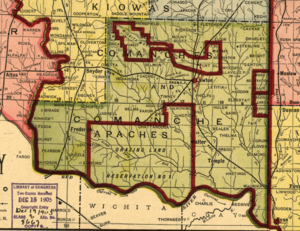Big Pasture facts for kids
The Big Pasture was a huge area of flat grassland, about 488,000 acres (1,975 square kilometers), located in what is now southwestern Oklahoma. This land was originally set aside for the Kiowa, Comanche, and Apache Native American tribes to use for grazing their animals. However, after 1901, the tribes often leased much of this land to large ranchers. This is how it got its name, "Big Pasture." The land was kept for grazing until 1906. Then, the government decided to divide it up. Some land was given to children born into the tribes, and the rest was sold. This was the last big piece of land opened for settlement in Oklahoma Territory.
Contents
Exploring the Big Pasture
Some old newspaper stories suggest that Francisco Vázquez de Coronado, a Spanish explorer, might have traveled through the middle of the Big Pasture. He was searching for a legendary golden city called Quivira.
Roosevelt's Famous Visit
In 1905, the Big Pasture was the site of a well-known wolf hunt. Theodore Roosevelt, who was the President of the United States at the time, came to visit. He especially wanted to see a man named John "Jack (Catch 'm Alive)" Abernathy from Frederick, Oklahoma. Abernathy was famous for catching wolves with his bare hands!
President Roosevelt's visit and his meeting with Quanah Parker, a famous Comanche chief, are often mentioned as reasons why he wanted to protect this area. He was determined to create the nearby Wichita Mountains Wildlife Refuge. He also wanted to bring buffalo back to live freely in the wild. The Wichita Mountains had already been protected as a forest preserve since 1901, thanks to President William McKinley.
Where Was the Big Pasture?
The Big Pasture was a strip of land about 29 miles (47 kilometers) from north to south and 36 miles (58 kilometers) from east to west. Today, this area is part of Comanche, Cotton, and Tillman counties in Oklahoma.
Towns in the Pasture
Several towns are located in what used to be the Big Pasture. These include Randlett, Devol, Grandfield, Loveland, and Hollister. Randlett is home to the Big Pasture Public Schools, which is a school system that serves students from Devol, Cookietown, and Randlett.
The Land Before Settlement
Before people settled there, the Big Pasture was mostly wide-open plains. It had a few areas with trees, mainly along two "draws" (small valleys or ravines). In 1852, Captain Randolph B. Marcy explored the Red River. He wrote that the wooded areas he found along Cache Creek were the last large groups of trees he saw until he reached the Rocky Mountains.


